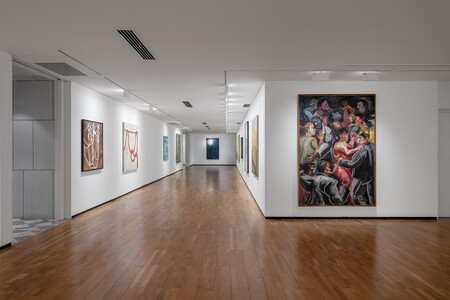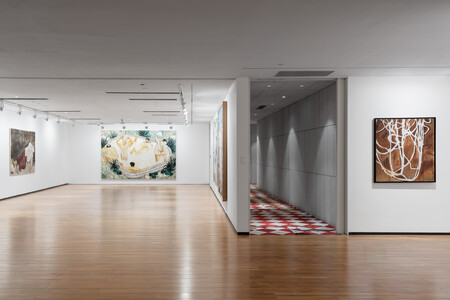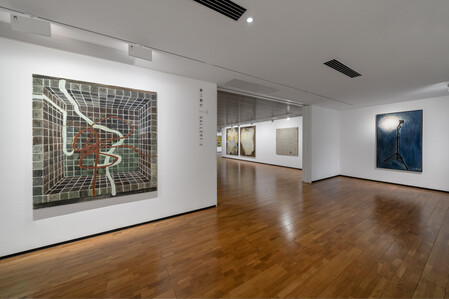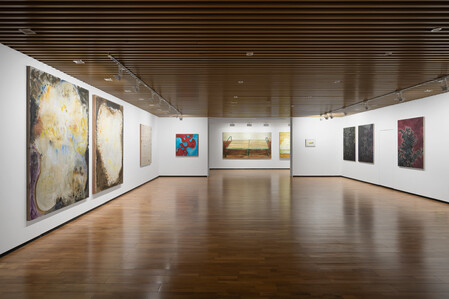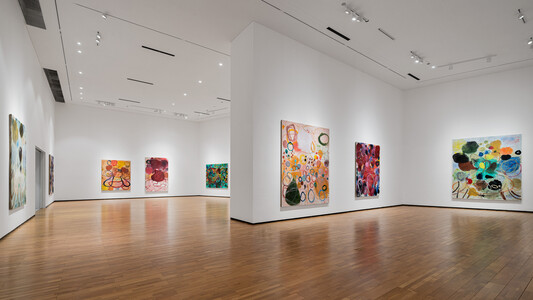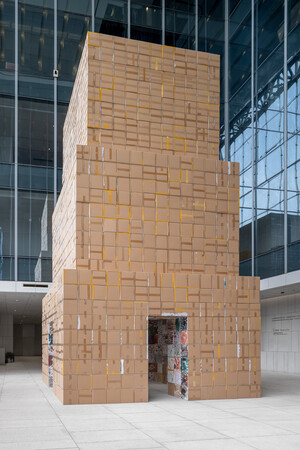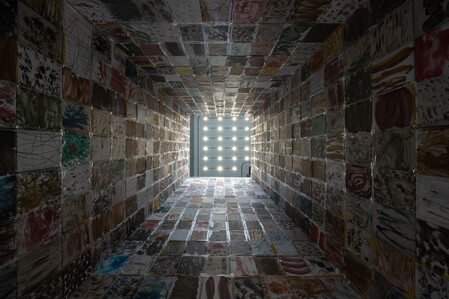Solo Exhibition Long Museum, Chongqing
Preface
Wang Wei, Co-founder and Director of Long Museum
“Zhang Enli: A Room with Colour” is the first large- scale retrospective exhibition held by Zhang Enli in Southwest China; I was very honored to be able to invite Zhang Enli to systematically present his more than 30 years of creations at Long museum Chongqing. There were more than 70 works on display, which covered Zhang’s urban portraits from the 1990s to the 2000s, the depiction of everyday objects from the 2000s to the early 2010s, as well as his abstract paintings and space painting installations in recent years.
The different stages of work reflect Zhang Enli’s 30 years of exploration in art creation, whether it is his early stage of character and portrait exploration, the latest abstract paintings, or his space painting installations, they all represent Zhang’s continuous focus on people, objects, and space. Each stage of Zhang’s works has its own style, but the changes in theme and technique are not sudden, instead it is a change that occurs naturally. When we look closely at Zhang’s different series of works, we can perceive the intimate connection between his pieces, that is, the artist’s concern for life and humanity from the beginning to the end.
In 2012, I collected Zhang Enli’s first piece of artwork, which was his piece titled “Vessel” created in 1995. Immediately after 2013, I collected his pieces “Two Jin of Beef” created in 1993 and “Bar” created in 1994. These three works were created in close years, but they happen to be different series of works in the same period. “Two Jin of beef” is one of Zhang’s most important works in his early “Butcher” series, it is filled with tension, emotion, and vibrant colours. “Bar” is from his “Pub” series, which depicts urban life in the 1990s. The colours, brushstrokes, and representations of the people in his pieces make the story in his artwork vivid. In the piece “Vessel”, the characters gently fade from the painting, and the theme of the work give way to the day-to-day objects in life that are casually placed on the table. It seems to me that this piece was Zhang’s earliest creative development and inspiration after his “Container” series in 2000.
In addition to several important pieces created by Zhang Enli in the 1990s, I also collected “The Smoker” (2002), “Big and Small Balls” (2012), ‘The Boss” (2019), “The Warrior” (2020), “A Farmer” (2020) as well as other pieces created in different periods. The themes of the works revolve around scenes of life and everyday objects, and in recent years, the expressions have become more and more condensed and highly abstract. Every piece of work I have collected I cherish very much.
In this exhibition, besides Zhang Enli’s orderly collection, he was also invited to present his “Space Painting” installations based on the space of Long Museum Chongqing, including the large-scale cardboard installations “Three-Storied Tower” (2020) located in the atrium on the first floor, and “The Colourful Floor” (2019) and “The Pendulous Pipe”(2014)in the exhibition hall on the second floor. Through these artworks, we can see Zhang’s inherent high sensitivity to space and painting. Zhang’s use of cardboard box to construct large-scale paintings installations is also a response to his long- standing concern for sparse and ordinary objects. It is precisely these ordinary things that make it easier for the viewer to enter his work and be moved by them.
I often feel a sense of relaxation when viewing Zhang’s creations, because his pieces are filled with the poetic quality of humanity. Zhang’s works are not shelf art but works that participate in daily life. I hope this exhibition will bring a brand-new artistic experience to the audience of Chongqing and the Southwest region of China!
From 19th September to 19th December 2021, Long Museum (Chongqing) presents the exhibition “Zhang Enli: A Room with Colour”. Curated by Wang Wei, director of the Long Museum, is the first major retrospective of Zhang’s works in the Southwest of China. It will feature over 70 works, including urban portraits from the 1990s to the early 2000s, depictions of everyday objects from the 2000s to the 2010s, abstract paintings and “space painting” installations created in recent years, as well as several manuscripts and a video. These works systematically present the artist’s 30-year creative journey.
Zhang’s works have been collected by the Tate Modern, and have been exhibited at the Centre Pompidou in Paris, amongst other institutions. Each stage of Zhang’s works has its own style, but the changes in theme and technique are not sudden, but rather a natural shift in style throughout his work. When we look closely at Zhang’s different series of works, we can perceive the intimate connection between them, that is, the artist’s constant concern for humanity, for everyday objects, for life, and for space.
The first part of the exhibition begins with figurative portraits, created between 1990 and 2005. These depict ordinary people in meat markets, pubs, dance halls, banquets, and baths, which were central themes in the artist’s work from the 1990s to the beginning of the new century. Chinese society in the 1990s experienced rapid change under the wave of reform, with people reveling in the new and trendy consumer culture brought about by rapid urbanization. As a marginalized artist in a neglected corner of Shanghai, Zhang was both a calm observer and an active participant in the whirlwind of the times in which he lived. The imagery in his paintings come from friends and colleagues around him, such as a woman walking down the street, people buying food in the vegetable market, and so on. Through the observation of different characters and scenery, the essence of the artist’s exploration is reflected: a constant concern for the human condition, as well as for himself, which has been present throughout his entire artistic career.
The second part of the exhibition is a continuation of the series of everyday objects from 2003 to the 2010s, ranging from figurative “objects” to universal “objects” that use pure blocks of colour, line, and shape as a means of expression. The object is a functional presence that is always associated with people, but it is also an ordinary reality of existence in space. The presence of objects tells an implicit narrative about people, and as a universal presence in the human environment, it reflects the state of human life. The everyday objects series has been an iconic period throughout the artist’s career for over a decade, and the objects in this exhibition include leather tubes, cardboard boxes, ball nets, mattresses, iron frame beds, mosaic containers, trees, lamps, sofas, and much more. Zhang’s paintings have shifted from the noisy and loud expression of “People” to the silent period of “Objects”, with works such as “Container”, “Rope and leather tube”, “Tree”, and “Mosaic” being the main inspirational pieces for development, as well as for the exploration of abstract space paintings.
The third part of the exhibition is the “Portrait series”, featuring new works from the last three years. Zhang reinterprets the impressions that remain in his mind onto canvas, through colour, form, composition, mood, and spatial feeling. They are abstract in expression, but all have a figurative name, often named after the character’s occupation, state, experience and other characteristics. The titles of the pieces represent the artist’s exploration of the influence of the subconscious mind on memory and the abstract understanding of different characters states. Starting from the traces left in the depths of memory, the artist’s scribbles represent moments from the past, whilst improvising to capture the changes in personal psychology and environment in the present, condensing multiple dimensions of time, space, events, and individual reality onto the same piece of work. The seemingly irregular use of lines, blocks of colour and brush strokes are influenced from Zhang’s experience of traditional painting. Through time, by breaking down one’s inner habits and integrating the subtle perceptions of the external environment, the original strength and power of painting is achieved.
In addition, it is also worth mentioning that Zhang will present three “Space painting” installations in accordance with the spatial structure of Long Museum (Chongqing), including the large-scale cardboard box installation “Three-Storied Tower” (2020) in the atrium on the ground floor, “The Colourful Floor” (2019) in the exhibition hall on the first floor, and “The Pendulous Pipe” (2014). Through these works, viewers can see Zhang’s innate heightened sensitivity to space and painting. The artist’s use of cardboard boxes to construct large-scale painting installations echoes his long-standing concern with everyday objects. It is precisely these ordinary objects that make it easier for the viewer to enter his work and be moved by it.
More Pictures:
尤永谈张恩利:他是一个谜|Hi 艺术
肖像的秘密:与张恩利一起看《有颜色的房子》|TANC
张恩利:一条路,是你跟着别人走,还是别人跟着你走?|Noblesse
八爪怪和回旋舞步|展评张恩利个展《有颜色的房间》|财富堂
宁岱:上海先生张恩利 | 凤凰艺术
张恩利:绘画是无处不在的 | 99艺术网





